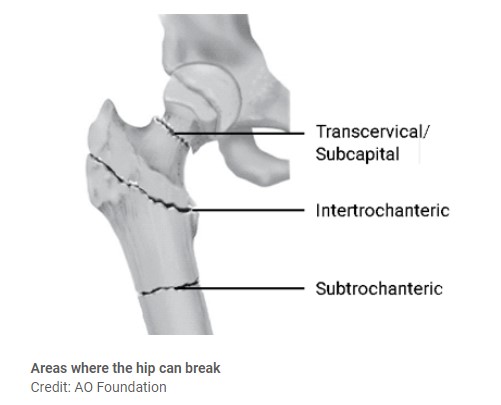Learning About Surgery to Repair a Hip Fracture

What is surgery for a hip fracture?
Surgery for a hip fracture repairs a broken hip bone. Broken hips are often caused by a fall or other injury. Some broken bones heal on their own. But a broken hip is not likely to heal well without surgery. This type of surgery is usually done soon after a hip breaks.
How is surgery for a hip fracture done?
The type of surgery your surgeon chooses will depend on the type of fracture you have, as well as other factors like your age and the quality of your bone.
Your surgery might use metal pins, screws, rods, or plates to attach the pieces of bone back together. The pins, screws, rods, and plates can be in different places, depending on your situation. The pictures below show some of the ways to fix a broken hip.

What can you expect after surgery for a hip fracture?
The day after your surgery
On the day after your surgery, you can expect to:
do your own self-care, like washing yourself
start physical therapy
get out of bed with help (follow your weight-bearing instructions)
sit in a chair for at least 1 meal
do your deep breathing and bed exercises
use a toilet with a raised seat or commode chair to go to the bathroom
You may still have your I.V. (intravenous) on the day after your surgery. You can also expect to:
restart your regular medicine, if your healthcare provider says to.
take medicine for pain or discomfort if you need to (especially before your physical therapy) or if your stomach is upset
keep taking a blood thinner
have blood work and other tests, as needed
have your bladder catheter taken out, if you have one
You can also expect to eat your meals and snacks, start taking calcium and vitamin D, and drink a nutritional supplement 3 or 4 times.
Days 2 to 5 after your surgery
On days 2 to 5 after your surgery, you may:
You can also expect to keep doing some everyday activities:
washing and dressing yourself
going for walks (wear supportive shoes)
sitting up in a chair for meals
eating your meals and snacks
drinking a nutritional supplement 3 or 4 times a day
You will also have physical therapy, occupational therapy, and other tests such as x-rays (as needed).
A physical therapist (also called a PT) will:
An occupational therapist (also called an OT) will:
help you learn how to use equipment that you may need at home
teach you how to do your self-care, like getting dressed
show you how to get in and out of bed, get on and off the toilet and chairs, get in and out of the tub or shower, and get in and out of a car
help you arrange the equipment and services you’ll need when you leave the hospital
Using walking aids
During your recovery, your healthcare team will show you how to walk properly with a walking aid. Let your healthcare team know if you’re worried about falling while you’re learning to walk and move around again.
Use a walking aid at all times to protect your hip. Your healthcare team will let you know which walking aid is right for you. Use your walking aid until your healthcare team says you don’t need it anymore. Walking aids include walkers, canes, or crutches.
Planning for when you leave the hospital
Your healthcare team will encourage you and your family or support person to be involved in your recovery and in planning for when you leave the hospital. Your healthcare team will ensure that it is safe for you to go home.
If you live in a different community than where you had your surgery, you may be sent to the hospital closer to your home. If you live in supportive living, you’ll go back there. If you’re not ready to go home, you may be moved to another area of the hospital or to another facility to keep working on your recovery.
You may need to use a walker, a cane, or crutches when walking for several months or longer after your surgery. At first, you may need help with daily activities such as bathing, dressing, and cooking. Rehab will help you get back to your regular activities. But it will probably take at least 3 months to return to your normal routine. It may take 6 months to 1 year for you to fully recover. Some people, especially older people, are never able to move as well as they used to.
You will slowly return to most of your activities.
Ask your doctor when you can drive again.
Ask your doctor when you can return to work. This can vary depending on your job and recovery.
Your doctor will tell you when you can walk, swim, dance, golf, or bicycle. Ask your doctor about other activities you would like to do.
Your doctor may advise you to avoid more strenuous activities, such as running or tennis, or activities where a fall is possible, such as horseback riding or skiing.
Follow-up care is a key part of your treatment and safety. Be sure to go to all appointments, and call your doctor or nurse advice line (811 in most provinces and territories) if you are having problems. It's also a good idea to know your test results and keep a list of the medicines you take.
To see this information online and learn more, visit MyHealth.Alberta.ca/health/pages/conditions.aspx?hwid=custom.ab_hipfracture_surgery_inst_adult.

For 24/7 nurse advice and general health information call Health Link at 811.
Current as of: February 7, 2025
Author: Fracture Liaison Services (FLS) Program, Alberta Health Services
This material is not a substitute for the advice of a qualified health professional. This material is intended for general information only and is provided on an "as is", "where is" basis. Although reasonable efforts were made to confirm the accuracy of the information, Alberta Health Services does not make any representation or warranty, express, implied or statutory, as to the accuracy, reliability, completeness, applicability or fitness for a particular purpose of such information. Alberta Health Services expressly disclaims all liability for the use of these materials, and for any claims, actions, demands or suits arising from such use.
